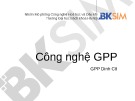
WELL CONTROL
Trình bày: ĐỖ QUANG KHÁNH
Bộ môn Khoan – Khai thác Dầu khí
Khoa Kỹ thuật Địa chất và Dầu khí
Đại học Bách Khoa TP. HCM
Email: dqkhanh@hcmut.edu.vn

GEOPET Well Control 2
CONTENT
1. INTRODUCTION
2. WELL CONTROL PRINCIPLES
3. WARNING SIGNS OF KICKS
4. SECONDARY CONTROL

GEOPET Well Control 3
CONTENT
5. WELL KILLING PROCEDURES
6. BOP EQUIPMENT
7. BOP STACK ARRANGEMENTS
8. EXERCISES

GEOPET Well Control 4
1. INTRODUCTION

GEOPET Well Control 5




![Bài giảng Công nghệ sản xuất CNG [chuẩn SEO]](https://cdn.tailieu.vn/images/document/thumbnail/2016/20160608/ntchung8894/135x160/8971465397664.jpg)
![Bài giảng Thiết bị phản ứng trong công nghiệp hóa dầu [mới nhất]](https://cdn.tailieu.vn/images/document/thumbnail/2016/20160608/ntchung8894/135x160/8551465397592.jpg)













![Bài giảng Chế biến khoáng sản vô cơ [Mới nhất]](https://cdn.tailieu.vn/images/document/thumbnail/2025/20251025/thanhvan173002/135x160/21521761538638.jpg)






